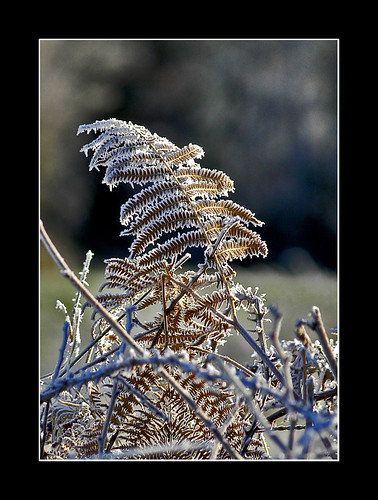Fougère, Coumarin and the Bittersweetness of Green
It is the coumarin that adds the crystalline quality to Fougères, as well as its over all warm bitter-sweetness. Perhaps this is why I enjoy wearing Fougères at this time of year. It has the quiet melancholy of Fall, yet with a cuddly softness added to it.
It was Fougère Royale (1882) by Houbigant that marked the birth of modern perfumery. While many consider Jicky (1889) as the mother of modern perfumery, it was in fact precedent by the legendary Fougère Royale, unlike the prehistoric fern it was named after, didn’t survive as well and the fragrance is no longer in production. However, it’s fame can be measured not by its survival achievements, but by the fact that an entire masculine fragrance family (or perfume genre) is named after it. Despite of that, a closer look at the perfume timeline reveals that the concept of Fougère has existed earlier:
In 1873 English Lavender by Yardley was released, blending notes of Lavender, Bergamot, Rosemary, Eucalyptus, Geranium, Clary Sage, Cedarwood, Tonka, Moss and Musk. Considering that tonka bean contains mostly coumarin, and that all the other important elements of Fougère (lavender, oakmoss, coumarin and herbs) are present, this might have been the first Fougère .
1877 brought Wild Fern by Geo F Trumper (with notes of oakmoss, basil and amber), again with both a name and a composition that suggests a Fougère (but who had smelled it that could confirm???).
Fougère, or Fern in French, is most known for its remarkable botanical versatility and resilience (as I said earlier, it has been probably been around since the days of the dinosaurs, it is such an ancient life form that it reproduces with spores and has no real leaves, but “fronds” ) and little known for its scent. However, ferns have a rich usage in human history for various uses: the dried underground stems of several species used to be ground into a starchy meal-like substance that is nourishing in times of famine (and in particular - Pteris esculenta in the Pacific Islands they have been a staple food); and the ashes of burnt fern in Wales were formed into balls and sold as “Ash Balls” and performed similarly to soap because of their high alkali levels (Poucher, W.A., “Perfumes, Cosmetics & Soaps, Vol.2). Certain ferns might be extracted for medicinal purposes (for their filmarone content – a yellow, amorphous acid which chases away worms).
In perfumery, however, any Fougère composition will have very little power for vermifuge purposes. It is simply a name for a complex blend of an aromatic, herbal nature. The key for compounding a Fougère is using the essential accord of lavender and linalol (either synthetic or from natural source – i.e. Ho Leaf or Rosewood), oakmoss absolute and coumarin (of synthetic or natural source – i.e. tonka bean or liatrix).
There are several sub-categories for the Fougère family:
Fougère Fresh
Dominant lavender freshness and dryness. These Fougères are herbaceous, spicy, fresh and woody. For example: l’Herbe Rouge
Fougère Ambery
Additional vanillic notes may increase the softness, to create a Fougère Ambery fragrance. These are soft and enveloping, and somewhat powdery. Canoe by Dana is an example of such composition, which is further sweetened by tonka and heliotropin.
Fougère Woody
Additional woody notes such as sandalwood, agarwood and vetiver create a cleaner and drier impression.
Fougère Floral
These Fougères are very complex, with the addition of bright florals such as neroli, lily of the valley, and cyclamen. The dryness of lavender and spicy, ambery and woody notes makes these more masculine. Jicky (Guerlain) is a good example for such floral – with neroli at the heart, and a soft tonka and amber base accompanying the Fougère accord.
The Modern “Face” of Fougère
Many modern masculine fragrances are touted as being Fougère. Scents such as Cool Water (for men) by Davidoff are such examples, and so are many others. However, the overdose of synthetic molecules (such as calone and other aquatic aromachemicals) and the declining percentage of important natural such as lavender and oakmoss in those compositions render the Fougère in these perfumes nearly absent. A good fougere in my mind has a balance of those intense, isolated molecules with a good measures of naturals that give it its aromatic flavour.
How To Make A Natural Fougère?
Start with the basics – excellent quality building blocks that are essential for Fougère: oakmoss absolute, lavender essential oil, absolute and concrete, rosewood or ho leaf (for a touch of linalool), and last but not least – a naturally sourced coumarin note, either from tonka bean absolute or liatrix tincture (you can make your own by soaking the dried leaves in 200 proof alcohol). Other useful notes are patchouli and vetiver. To these essentials, you may want to choose additional notes that would add a particular character to your Fougère. The following are suggested notes to choose from for a Fougère composition:
Top notes:
Lavender
Rosewood
Ho Leaf
Rosemary essential oil
Bergamot
Cedarwood, Virginian
Petitgrain, French
Neroli, French
Bitter Orange
White Grapefruit
Juniper Berries
Heart notes:
Lavender absolute
Clary sage
Rose Geranium
Jasmine absolute
Rose absolute
Rosemary absolute
Ylang ylang
Tuberose absolute
Lemongrass
Litsea Cubeba
Orange Blossom Absolute
Clove bud
Carnation absolute
Guiacwood
Base notes:
Oakmoss absolute
Tonka bean absolute (or tincture)
Liatrix tincture (or absolute)
Patchouli
Vetiver
Sandalwood
Agarwood
Cedarwood, Atlas
Vanilla
Benzoin
Myrrh
Cassie
Tarragon absolute
Clove bud absolute


